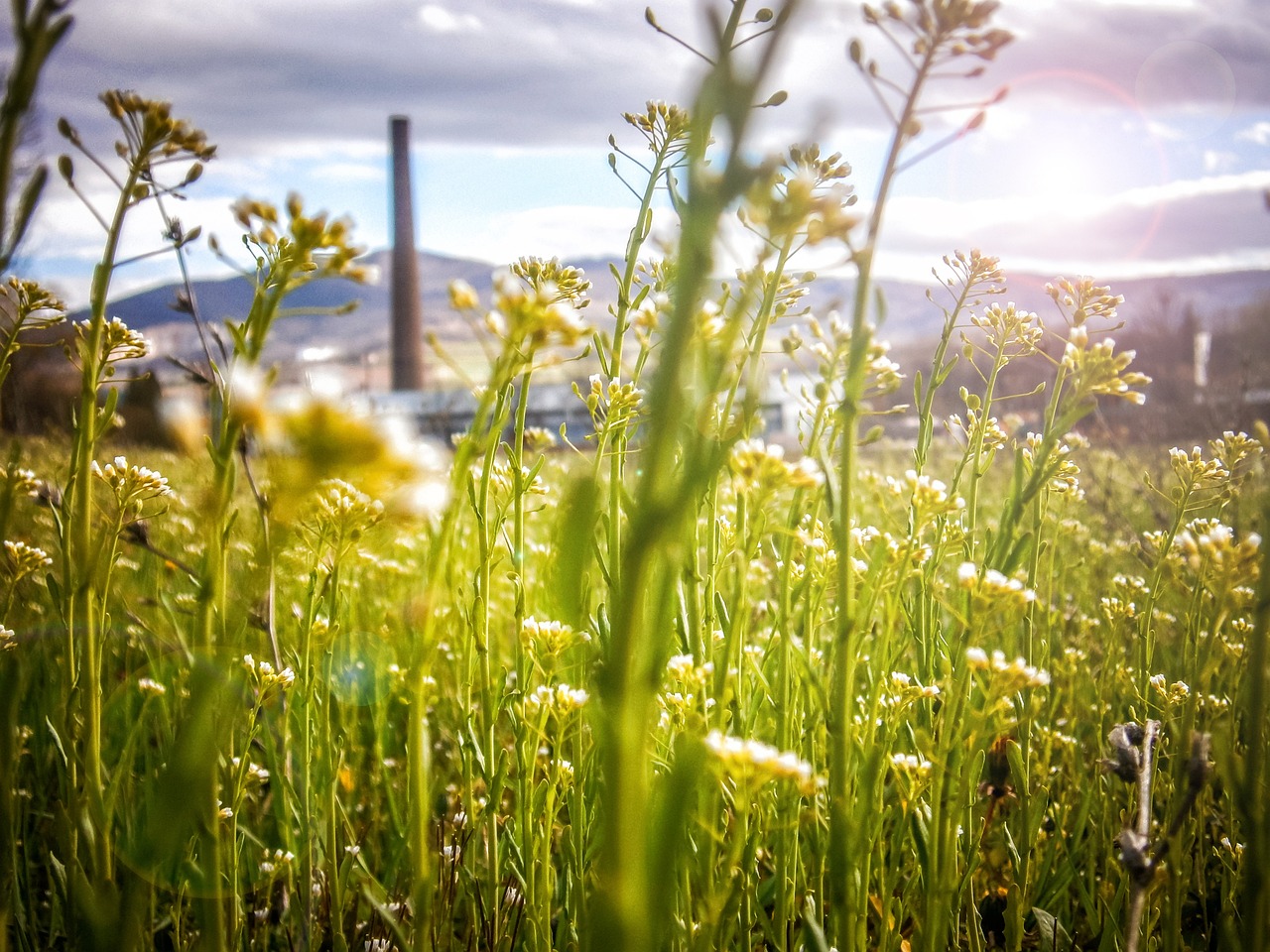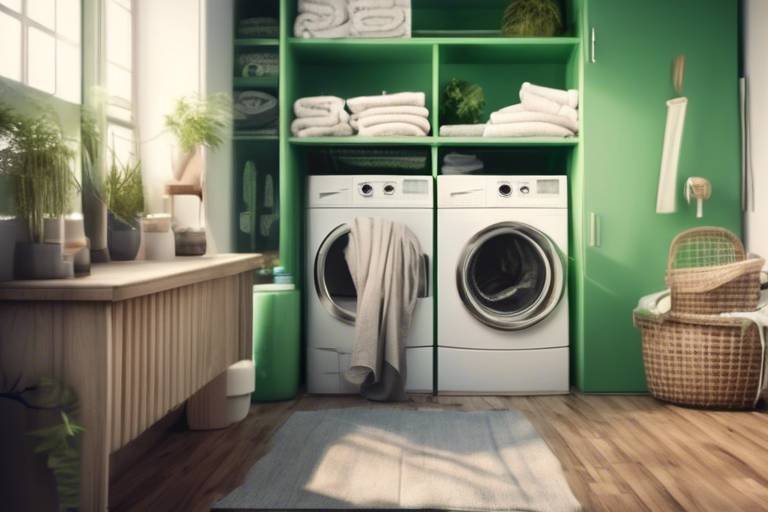What are Bioplastics and How are They Better?
In a world increasingly aware of its environmental footprint, bioplastics emerge as a beacon of hope. But what exactly are they? Bioplastics are materials made from renewable biomass sources, such as plants, rather than fossil fuels. This fundamental difference sets them apart from conventional plastics, which are notorious for their environmental impact. Imagine replacing harmful, petroleum-based plastics with materials that not only reduce waste but also help in combating climate change. Sounds revolutionary, right? Well, that's precisely what bioplastics aim to achieve.
Bioplastics can be categorized into two main types: bio-based plastics and biodegradable plastics. Bio-based plastics are derived from biological materials, while biodegradable plastics can decompose naturally in the environment. This dual functionality gives bioplastics a unique edge over traditional plastics, which can take hundreds of years to break down. The potential for bioplastics to significantly reduce our reliance on fossil fuels and lower pollution levels is not just a dream; it's becoming a reality.
As we delve deeper into the realm of bioplastics, it’s crucial to understand their applications and benefits. From packaging to automotive industries, bioplastics are making waves. But more than just being an alternative, they offer a sustainable solution that can align with our growing needs for eco-friendly materials. In essence, bioplastics represent a transformative shift in how we think about materials and their lifecycle. They are not just a trend; they are a necessary evolution in our approach to sustainability.
So, how do bioplastics compare to traditional plastics? The answer lies in their environmental benefits, applications, and overall impact on our planet. As we explore these aspects further, it becomes clear that bioplastics are not just better for the environment; they are essential for a sustainable future.
- What are the main sources of bioplastics? Bioplastics are primarily made from renewable resources such as corn starch, sugarcane, and potato starch.
- Are bioplastics more expensive than traditional plastics? Initially, bioplastics can be more expensive, but their long-term environmental benefits can outweigh the costs.
- Can bioplastics be recycled? Some bioplastics are recyclable, but it's essential to check local recycling guidelines, as not all facilities accept them.
- How long do bioplastics take to biodegrade? The biodegradation time varies depending on the type of bioplastic and environmental conditions, but they generally break down faster than conventional plastics.

Understanding Bioplastics
Bioplastics are a fascinating innovation in the world of materials, primarily derived from renewable biomass sources such as plants, corn, and even algae. Unlike traditional plastics, which are made from fossil fuels, bioplastics present a more sustainable alternative that aligns with our growing need for environmentally friendly solutions. This section will dive deep into the composition, types, and significant differences between bioplastics and conventional plastics, showcasing their potential to mitigate environmental challenges.
To understand bioplastics better, it's essential to recognize their two main categories: bio-based plastics and biodegradable plastics. Bio-based plastics are made from biological materials, while biodegradable plastics can decompose naturally in the environment. Some bioplastics fall into both categories, but not all bio-based plastics are biodegradable. This distinction is crucial as it influences their applications and environmental impact.
One of the most appealing aspects of bioplastics is their ability to be produced from renewable resources, which significantly reduces dependence on fossil fuels. This not only helps in conserving non-renewable resources but also contributes to a lower carbon footprint during production. For instance, polylactic acid (PLA), a popular type of bioplastic, is made from fermented plant starch, making it a viable alternative to petroleum-based plastics.
Moreover, bioplastics can be tailored to meet specific performance requirements, making them versatile for various applications. They can be engineered to have similar mechanical properties to traditional plastics, which means they can be utilized in everything from packaging materials to automotive parts. Here’s a quick overview of the types of bioplastics:
| Type of Bioplastic | Source | Properties |
|---|---|---|
| PLA (Polylactic Acid) | Corn starch, sugarcane | Biodegradable, clear, good barrier properties |
| PHA (Polyhydroxyalkanoates) | Bacteria fermentation of sugars | Biodegradable, flexible, high thermal stability |
| Starch-based Plastics | Natural starch | Biodegradable, often mixed with other polymers |
In summary, bioplastics represent a significant shift in our approach to materials, combining sustainability with functionality. Their production from renewable sources, coupled with their potential for biodegradability, positions them as a key player in reducing plastic pollution. As we continue to explore the environmental benefits of bioplastics, their role in various industries becomes increasingly vital for a sustainable future.

Environmental Benefits
Bioplastics are not just a trendy alternative to traditional plastics; they represent a significant leap forward in our quest for a more sustainable future. The environmental benefits of bioplastics are both profound and multifaceted, making them a compelling choice for industries and consumers alike. By utilizing renewable resources, bioplastics help reduce our reliance on fossil fuels, which is a major contributor to greenhouse gas emissions. This shift is crucial, especially as we grapple with the pressing realities of climate change.
One of the standout features of bioplastics is their potential for biodegradability. Unlike conventional plastics, which can linger in our environment for hundreds of years, many bioplastics can break down naturally under the right conditions. This means that they can decompose into harmless substances, returning nutrients to the soil rather than contributing to the ever-growing problem of plastic pollution. To put this into perspective, consider the staggering amount of plastic waste generated globally—over 300 million tons annually! Imagine if a significant portion of that could simply disappear in a matter of months instead of decades.
Moreover, the production of bioplastics typically generates fewer greenhouse gases compared to traditional plastic manufacturing. This reduction is largely due to the use of biomass, which absorbs carbon dioxide as it grows. Thus, the lifecycle of bioplastics is inherently more sustainable. To illustrate this point, let’s take a look at the following table comparing the carbon emissions from bioplastics and conventional plastics:
| Type of Plastic | Carbon Emissions (kg CO2e per kg produced) |
|---|---|
| Conventional Plastics | 6.0 - 8.0 |
| Bioplastics | 3.0 - 5.0 |
This table highlights a stark contrast—bioplastics can reduce carbon emissions by nearly half! This kind of reduction is not just a drop in the ocean; it’s a tidal wave of change that can significantly impact our planet’s health.
Furthermore, the ability of bioplastics to be composted adds another layer of environmental benefit. When disposed of in appropriate composting facilities, bioplastics can break down efficiently, enriching the soil and supporting plant growth. However, it’s essential to note that not all bioplastics are created equal; some require industrial composting conditions to degrade effectively. This emphasizes the importance of proper waste management systems to maximize the environmental benefits of bioplastics.
In conclusion, the environmental benefits of bioplastics are clear and compelling. By reducing carbon emissions, promoting biodegradability, and enhancing soil health through composting, bioplastics offer a sustainable alternative to traditional plastics. As we continue to innovate and adapt, embracing bioplastics could play a pivotal role in our efforts to combat pollution and protect our planet for future generations.
- What are bioplastics made from? Bioplastics are primarily made from renewable biomass sources such as corn, sugarcane, and potato starch.
- Are bioplastics biodegradable? Many bioplastics are biodegradable, but the conditions for their decomposition can vary. Some require industrial composting facilities to break down effectively.
- How do bioplastics compare to traditional plastics in terms of cost? Currently, bioplastics may be more expensive to produce than traditional plastics, but prices are expected to decrease as technology advances and production scales up.
- Can bioplastics be recycled? While some bioplastics can be recycled, the recycling processes for bioplastics and traditional plastics are different, and not all recycling facilities accept bioplastics.

Carbon Footprint Reduction
When we think about the environmental impact of our daily choices, one of the biggest culprits that often comes to mind is plastic. The production of traditional plastics is notorious for its high carbon emissions, which contribute significantly to climate change. In contrast, bioplastics emerge as a beacon of hope in this grim scenario. Derived from renewable biomass sources, bioplastics offer a more sustainable alternative, generating fewer greenhouse gases during their production process.
To truly grasp the impact of bioplastics on our carbon footprint, it’s essential to understand the processes involved in their creation. Unlike conventional plastics, which are typically made from fossil fuels, bioplastics are sourced from materials like corn starch, sugarcane, and even agricultural waste. This shift in raw materials not only reduces reliance on finite resources but also harnesses the natural carbon cycle. As plants grow, they absorb carbon dioxide from the atmosphere, and when they are processed into bioplastics, this carbon is effectively locked away, preventing it from contributing to greenhouse gas emissions.
But how much of a difference does this really make? Studies have shown that the production of bioplastics can result in up to 70% lower greenhouse gas emissions compared to traditional plastics. This is not just a small win; it’s a significant leap towards reducing our overall carbon footprint. To illustrate this point, let’s take a look at a comparative analysis:
| Type of Plastic | Greenhouse Gas Emissions (kg CO2 equivalent per ton) |
|---|---|
| Traditional Plastics | 1,800 |
| Bioplastics | 500 - 700 |
This table highlights the stark difference in emissions, showcasing the potential of bioplastics to mitigate climate change. Furthermore, the reduced carbon footprint of bioplastics extends beyond just production. When these materials reach the end of their life cycle, they also offer better options for disposal. Many bioplastics are designed to biodegrade, which means they can break down naturally in the environment, further reducing their overall impact.
In conclusion, the shift to bioplastics represents a crucial step towards a more sustainable future. By choosing materials that not only lower greenhouse gas emissions during production but also have the potential to decompose naturally, we can significantly reduce our carbon footprint. It’s a win-win situation for both consumers and the environment, paving the way for a cleaner, greener planet.
- What are bioplastics made from? Bioplastics are typically made from renewable biomass sources such as corn, sugarcane, and other plant materials.
- How do bioplastics compare to traditional plastics? Bioplastics generally produce fewer greenhouse gas emissions during production and can biodegrade under the right conditions, making them more environmentally friendly.
- Are all bioplastics biodegradable? Not all bioplastics are biodegradable; it depends on the specific type and the conditions in which they are disposed of.
- Can bioplastics be recycled? Some bioplastics can be recycled, but recycling facilities may not always accept them, so it’s essential to check local guidelines.

Life Cycle Analysis
When we talk about the environmental impact of any material, life cycle analysis (LCA) becomes a crucial tool in our toolkit. It’s like a magnifying glass that allows us to scrutinize every phase of a product's life—from the raw materials used to its eventual disposal. In the case of bioplastics, this analysis reveals fascinating insights about their sustainability compared to traditional plastics.
The LCA of bioplastics typically encompasses several key stages:
- Raw Material Extraction: This is where it all begins. Bioplastics are derived from renewable resources, such as corn starch or sugarcane, rather than fossil fuels. This fundamental difference sets the stage for a lower environmental impact.
- Production: The manufacturing process of bioplastics often requires less energy, leading to a reduction in greenhouse gas emissions. This is a significant factor in their favor.
- Usage: During their lifecycle, bioplastics can serve similar functions as conventional plastics, but with the added benefit of being less harmful to the environment.
- Disposal: Perhaps the most exciting aspect is how bioplastics can biodegrade under the right conditions, unlike their traditional counterparts, which can linger in landfills for centuries.
To put this into perspective, let's consider a comparative table that outlines the differences in emissions and resource usage between bioplastics and conventional plastics:
| Stage | Conventional Plastics | Bioplastics |
|---|---|---|
| Raw Material Source | Fossil Fuels | Renewable Biomass |
| Energy Consumption | High | Lower |
| Greenhouse Gas Emissions | Higher | Lower |
| Biodegradability | Non-biodegradable | Biodegradable |
As we can see from the table, the environmental impact of bioplastics is significantly lower at each stage of their lifecycle. This is not just a matter of numbers; it's about the future we want for our planet. By adopting bioplastics, we are taking a step towards a more sustainable and eco-friendly world. Additionally, LCA studies have shown that the overall energy savings and reduced emissions during the life cycle of bioplastics can contribute to a meaningful decrease in our carbon footprint.
In conclusion, conducting a life cycle analysis of bioplastics highlights their potential not just as an alternative to traditional plastics, but as a necessary evolution in how we think about materials and waste. It’s a journey worth taking for the sake of our environment and future generations.
- What are bioplastics made from? Bioplastics are made from renewable biomass sources such as corn starch, sugarcane, or even food waste.
- Are bioplastics biodegradable? Yes, many bioplastics are designed to biodegrade under specific conditions, making them a more sustainable option than traditional plastics.
- How do bioplastics compare in cost to traditional plastics? While bioplastics can be more expensive to produce, the long-term environmental benefits often outweigh the initial costs.
- Can bioplastics be recycled? Some bioplastics can be recycled, but the recycling infrastructure for them is still developing.

Comparative Emissions
When we talk about emissions, it's crucial to understand the stark contrast between bioplastics and traditional plastics. The production processes for these materials yield different levels of greenhouse gases, which ultimately affect our environment. Studies have shown that bioplastics can significantly reduce emissions, making them a more sustainable choice. For instance, a life cycle assessment of various bioplastic types has revealed that they can produce up to 70% fewer greenhouse gas emissions than their petroleum-based counterparts.
One of the key reasons for this reduction is the source of the raw materials. While traditional plastics are derived from fossil fuels, bioplastics are made from renewable resources such as corn, sugarcane, and even waste materials. This shift from fossil fuels to renewable biomass not only diminishes the carbon footprint but also promotes a more circular economy. The table below illustrates the comparative emissions of bioplastics versus traditional plastics:
| Type of Plastic | Greenhouse Gas Emissions (kg CO2 equivalent per kg) |
|---|---|
| Conventional Plastics | 6.0 - 8.0 |
| Bioplastics (e.g., PLA) | 1.5 - 2.5 |
This table highlights a significant difference in the emissions associated with each type of plastic. It's important to note that while bioplastics still produce emissions, their overall impact is considerably lower. Additionally, the production methods for bioplastics often incorporate renewable energy sources, further minimizing their carbon footprint.
Moreover, the comparative emissions data reflects not just the production phase but also considers the entire life cycle from extraction to disposal. This comprehensive approach is essential for understanding the true environmental impact of these materials. Studies have shown that bioplastics, when disposed of properly, can lead to a net reduction in greenhouse gases, especially when composted, as they break down into organic matter rather than contributing to landfill waste.
In conclusion, the comparative emissions of bioplastics versus traditional plastics reveal a promising path towards reducing our environmental impact. By choosing bioplastics, we are not just opting for an alternative material but are actively participating in a more sustainable future. The transition to bioplastics could be the key to mitigating climate change and fostering a healthier planet for generations to come.
- What are bioplastics made from?
Bioplastics are primarily made from renewable biomass sources such as corn, sugarcane, and other plant materials. - Are bioplastics biodegradable?
Yes, many bioplastics are designed to be biodegradable or compostable, breaking down into natural materials under the right conditions. - How do bioplastics impact the environment?
Bioplastics generally have a lower carbon footprint and contribute less to greenhouse gas emissions compared to traditional plastics. - Can bioplastics be recycled?
Some bioplastics can be recycled, but it depends on the type and local recycling facilities. Always check with your local guidelines.

Biodegradability and Composting
One of the most compelling features of bioplastics is their ability to biodegrade under the right conditions, setting them apart from their conventional plastic counterparts. Unlike traditional plastics, which can linger in the environment for hundreds of years, bioplastics are designed to break down more quickly, reducing their long-term environmental impact. But what does biodegradability really mean? In simple terms, it refers to the process by which organic substances are decomposed by living organisms, primarily microorganisms, into natural elements like water, carbon dioxide, and biomass. This process not only helps to minimize waste but also supports the idea of a circular economy.
However, it's essential to note that not all bioplastics are created equal when it comes to biodegradability. Some require specific conditions to decompose effectively. For instance, certain bioplastics might need industrial composting facilities to break down properly, where controlled temperatures and humidity levels are maintained. This is in stark contrast to conventional plastics, which often end up in landfills or oceans, contributing to pollution and harming wildlife.
To better understand the conditions required for biodegradation, consider the following factors:
- Temperature: Higher temperatures typically accelerate the decomposition process.
- Moisture: Sufficient moisture is crucial for microorganisms to thrive and break down materials.
- Oxygen Levels: Aerobic conditions (presence of oxygen) are often necessary for effective biodegradation.
Additionally, the concept of composting plays a pivotal role in the biodegradation of bioplastics. Composting is a natural process that transforms organic waste into valuable compost, which can enrich soil and support plant growth. When bioplastics are composted, they can contribute to this nutrient cycle, making them a more sustainable choice compared to traditional plastics. However, the challenge lies in ensuring that consumers have access to the right composting facilities. Without proper infrastructure, the benefits of bioplastics can be significantly diminished.
As we continue to explore the potential of bioplastics, it's crucial to raise awareness about the importance of composting and the specific conditions required for effective biodegradation. By doing so, we can encourage responsible disposal practices and help pave the way for a more sustainable future. The shift towards bioplastics is not just about replacing one material with another; it's about redefining our relationship with materials and understanding the impact of our choices on the environment.
- What are bioplastics made from? Bioplastics are typically derived from renewable biomass sources, such as corn starch, sugarcane, or potato starch, rather than fossil fuels.
- How long do bioplastics take to biodegrade? The time it takes for bioplastics to biodegrade can vary widely based on environmental conditions, ranging from a few months to several years.
- Can all bioplastics be composted? Not all bioplastics are compostable. Some require industrial composting facilities, while others may break down in home composting systems.
- Are bioplastics more expensive than traditional plastics? Currently, bioplastics can be more expensive to produce than conventional plastics, but prices are expected to decrease as technology advances and demand increases.

Applications of Bioplastics
Bioplastics are not just a trendy buzzword; they are revolutionizing various industries by providing sustainable alternatives to traditional plastics. Their versatility is astounding, and they are increasingly being adopted across multiple sectors, from packaging to automotive. Imagine a world where the materials we use daily contribute positively to the environment rather than harm it. This is the promise of bioplastics.
One of the most significant areas where bioplastics are making waves is in the packaging industry. With growing concerns about plastic waste, companies are turning to bioplastics to create packaging solutions that are not only effective but also environmentally friendly. For instance, bioplastics derived from corn starch or sugarcane are being used to produce biodegradable bags, wrappers, and containers. This shift is essential as it helps reduce the amount of plastic that ends up in landfills and oceans, thus protecting wildlife and natural ecosystems.
In addition to packaging, the medical field is witnessing a remarkable transformation thanks to bioplastics. Medical devices, such as syringes, surgical instruments, and implants, are increasingly being made from bioplastics. These materials are not only safer for patients but also offer a sustainable option that minimizes environmental impact. For example, bioplastics can be designed to biodegrade after use, eliminating the need for hazardous waste disposal. This is particularly important in a field where safety and sustainability are paramount.
To give you a clearer picture, let’s take a look at some common applications of bioplastics:
| Application | Description | Benefits |
|---|---|---|
| Packaging | Biodegradable bags, wrappers, and containers. | Reduces plastic waste and environmental impact. |
| Medical Devices | Syringes, surgical instruments, and implants. | Safer for patients and reduces hazardous waste. |
| Automotive Parts | Interior components, dashboards, and insulation. | Lightweight and sustainable alternatives to traditional materials. |
| Consumer Goods | Toys, utensils, and electronics casings. | Eco-friendly options that appeal to environmentally conscious consumers. |
As you can see from the table, the applications of bioplastics are diverse and impactful. The automotive industry is also exploring the potential of bioplastics, utilizing them for interior components, dashboards, and insulation. These materials not only offer a lightweight alternative but also help manufacturers meet sustainability goals. The shift towards bioplastics in these areas reflects a broader trend of companies prioritizing eco-friendly practices, which resonates with consumers who are increasingly demanding greener products.
In the realm of consumer goods, bioplastics are being used to create everything from toys to utensils and electronic casings. This shift is not just a passing trend; it represents a significant change in how companies are viewing their environmental responsibilities. With consumers becoming more environmentally conscious, businesses are recognizing the importance of aligning their products with sustainable practices. By choosing bioplastics, companies can not only reduce their carbon footprint but also appeal to a growing market of eco-friendly consumers.
In conclusion, the applications of bioplastics are vast and varied, touching nearly every aspect of our lives. From packaging that decomposes naturally to medical devices that prioritize safety and sustainability, bioplastics are paving the way for a greener future. As technology continues to advance, we can expect to see even more innovative uses for bioplastics, further solidifying their role as a crucial component in the quest for sustainability.
- What are bioplastics made from? Bioplastics are primarily made from renewable biomass sources such as corn starch, sugarcane, and even algae.
- Are bioplastics biodegradable? Many bioplastics are designed to be biodegradable, meaning they can break down naturally in the environment under the right conditions.
- How do bioplastics compare to traditional plastics? Bioplastics typically have a lower carbon footprint and can be more environmentally friendly, especially if they are biodegradable.
- Where are bioplastics commonly used? Bioplastics are used in various applications, including packaging, medical devices, automotive parts, and consumer goods.

Packaging Solutions
When it comes to the packaging industry, bioplastics are rapidly becoming the go-to solution for companies looking to reduce their environmental footprint. Traditional packaging materials, primarily made from petroleum-based plastics, contribute significantly to pollution and waste. In contrast, bioplastics are derived from renewable resources such as corn starch, sugarcane, and even food waste, making them a more sustainable choice. This shift not only helps in minimizing the reliance on fossil fuels but also promotes a circular economy where materials are reused and recycled.
One of the standout features of bioplastics is their versatility. They can be molded, shaped, and designed to meet various packaging needs, from food containers to protective wraps. For instance, PLA (Polylactic Acid) is a commonly used bioplastic in the food packaging sector due to its excellent barrier properties and ability to biodegrade under the right conditions. Similarly, PHA (Polyhydroxyalkanoates) is gaining traction for its superior biodegradability and is often used in single-use items like cutlery and straws.
Moreover, the adoption of bioplastics in packaging comes with several benefits:
- Reduced Environmental Impact: Bioplastics can significantly lower carbon emissions during production compared to their traditional counterparts.
- Compostability: Many bioplastics can break down in industrial composting facilities, thereby reducing landfill waste.
- Consumer Appeal: As consumers become more environmentally conscious, brands utilizing bioplastics can enhance their market appeal and customer loyalty.
However, it's essential to note that while bioplastics are a step in the right direction, they are not a one-size-fits-all solution. The effectiveness of bioplastics largely depends on the availability of appropriate composting facilities and the specific conditions under which they are disposed of. For example, many bioplastics require industrial composting conditions to break down effectively, which may not be available in all areas. Therefore, educating consumers about proper disposal methods is crucial for maximizing the benefits of bioplastics.
As the demand for sustainable packaging grows, companies are investing in innovative bioplastic solutions that not only meet regulatory standards but also align with consumer expectations. This evolution in packaging technology is paving the way for a more sustainable future, where packaging materials are not just discarded but are part of a larger system of reuse and recycling.
1. What are bioplastics made from?
Bioplastics are primarily made from renewable biomass sources such as corn starch, sugarcane, and even food waste. This makes them a more sustainable alternative to traditional plastics derived from fossil fuels.
2. Are bioplastics biodegradable?
Many bioplastics are designed to be biodegradable; however, they often require specific conditions to break down effectively, such as industrial composting facilities.
3. Can bioplastics be recycled?
While some bioplastics can be recycled, they often need to be processed separately from traditional plastics due to differences in their chemical composition. It's crucial to check local recycling guidelines.
4. How do bioplastics compare to traditional plastics in terms of cost?
Currently, bioplastics can be more expensive to produce than traditional plastics, but as technology advances and demand increases, prices are expected to become more competitive.

Medical Uses
Bioplastics are paving the way for a revolution in the medical field, offering a plethora of advantages that traditional plastics simply cannot match. Imagine a world where medical devices are not only effective but also environmentally friendly! This is becoming a reality thanks to the innovative applications of bioplastics. From surgical tools to drug delivery systems, the potential of bioplastics is vast and exciting.
One of the standout features of bioplastics in medicine is their biocompatibility. This means that these materials are less likely to cause adverse reactions in the body, making them ideal for use in implants and other medical devices. For instance, polylactic acid (PLA), a common bioplastic, is often used in sutures and scaffolds for tissue engineering. These applications are crucial, as they not only support healing but also reduce the risk of complications associated with traditional materials.
Moreover, bioplastics can be engineered to degrade safely in the body over time. This is particularly beneficial for temporary implants, such as stents or drug delivery systems, which need to dissolve after serving their purpose. The ability to customize the degradation rate allows for tailored treatments, ensuring that patients receive optimal care without the need for additional surgeries to remove devices.
In addition to surgical applications, bioplastics are also finding their way into packaging for medical products. The packaging industry is increasingly adopting bioplastics for items like syringes and IV bags. This shift not only reduces the environmental impact of medical waste but also enhances safety by minimizing the risk of contamination. Imagine a patient receiving a medication in a biodegradable package—this not only benefits the environment but also promotes a cleaner healthcare system.
As we look toward the future, the innovations in bioplastics are just beginning to unfold. Research is ongoing to develop new types of bioplastics that can withstand sterilization processes and meet stringent regulatory requirements. The potential for bioplastics to replace conventional materials in medical applications is not just a dream; it's becoming a tangible reality.
In summary, the medical uses of bioplastics highlight their versatility and sustainability. As the healthcare industry continues to adopt these materials, we can expect to see a significant reduction in environmental impact while improving patient outcomes. The future is bright for bioplastics in medicine, and it's exciting to think about what lies ahead!
- What are bioplastics made from? Bioplastics are derived from renewable biomass sources, such as corn starch, sugarcane, and other plant materials.
- Are bioplastics biodegradable? Yes, many bioplastics are designed to biodegrade under certain conditions, making them a more sustainable option than traditional plastics.
- Can bioplastics be used in medical applications? Absolutely! Bioplastics are increasingly used in medical devices, packaging, and implants due to their biocompatibility and safety.
- How do bioplastics compare to traditional plastics? Bioplastics generally have a lower carbon footprint and are often biodegradable, making them more environmentally friendly than conventional plastics.
Frequently Asked Questions
- What are bioplastics made from?
Bioplastics are primarily made from renewable biomass sources such as corn, sugarcane, and potatoes. Unlike traditional plastics, which are derived from fossil fuels, bioplastics utilize natural materials, making them a more sustainable option for various applications.
- How do bioplastics benefit the environment?
Bioplastics offer several environmental benefits, including a reduced carbon footprint and biodegradability. They help lower greenhouse gas emissions during production and can break down more easily in natural environments, contributing to less pollution and waste.
- Are all bioplastics biodegradable?
Not all bioplastics are biodegradable. While some bioplastics can decompose under specific conditions, others may require industrial composting facilities to break down effectively. It's essential to check the labeling and specifications of each product to understand its disposal requirements.
- Can bioplastics be recycled?
Yes, certain bioplastics can be recycled, but the recycling process may differ from that of traditional plastics. It's crucial to ensure that bioplastics are accepted by local recycling programs, as not all facilities can handle them. Always check with your local guidelines.
- What industries are using bioplastics?
Bioplastics are being adopted across various industries, including packaging, automotive, and medical sectors. They are particularly popular in packaging due to their sustainability, as well as in medical applications where safety and environmental impact are critical considerations.
- How do bioplastics compare to traditional plastics?
Bioplastics generally have a lower environmental impact than traditional plastics, primarily due to their renewable origins and potential for biodegradability. However, they may have different properties and performance characteristics, which can affect their suitability for specific applications.
- What is life cycle analysis in relation to bioplastics?
Life cycle analysis (LCA) is a method used to assess the environmental impact of a product from its production to disposal. For bioplastics, LCA helps in understanding their overall sustainability by evaluating factors such as resource use, emissions, and waste generation throughout their life cycle.
- Are bioplastics more expensive than traditional plastics?
Bioplastics can be more expensive to produce than traditional plastics due to the costs associated with sourcing renewable materials and the manufacturing processes involved. However, as technology advances and demand increases, prices are expected to become more competitive.



















